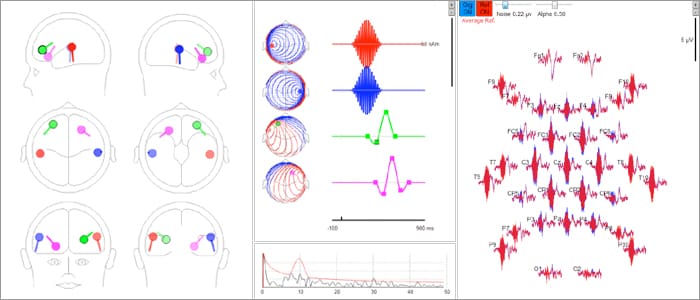
BESA Simulator
BESA Simulator is the perfect tool for simulating evoked and induced brain activity. This free software developed by Patrick Berg allows you to place your sources in the brain, assign them a time-course and save your data with an electrode layout of your choice. You can simulate average data or raw data choosing your own real dataset for overlaying the modeled activity. This allows simulating induced data, as well as evoked data. Use the simulated data to examine your source or coherence analysis techniques.
Create your own evoked and induced data
BESA is the most widely used software for source analysis and dipole localization in EEG and MEG research. BESA Research has been developed on the basis of 30 years experience in human brain research by the team around Michael Scherg, University of Heidelberg, and Patrick Berg, University of Konstanz.
BESA Research is a highly versatile and user-friendly Windows® program with optimized tools and scripts to preprocess raw or averaged data for source analysis and connectivity analysis. All important aspects of source analysis and source imaging are displayed in one window for immediate selection of a wide range of tools. The same holds true for the source coherence / time-frequency module, and other analysis windows. BESA Research provides fast and easy hypothesis testing, a variety of source analysis algorithms including cortical imaging and volume imaging methods, integration with MRI and fMRI, age-appropriate template head models (FEM) as well as the possibility to import individual head models (BEM and / or FEM) generated by BESA MRI.
Do you manage to localize the simulated sources? Use BESA Simulator to create your own theories about brain networks underlying your data and see if they hold true in real data. BESA Simulator is an ideal instrument for learning and also teaching about induced and evoked brain activity!

Features
With BESA Simulator you can:
- Simulate both EEG and MEG data
- See maps resulting from a dipole anywhere within the head
- Add any number of dipoles to a model
- Generate independent waveforms for each dipole (source waveforms). You can also read in source waveforms from an ASCII file (BESA swf)
- See the surface data resulting from the model as reference-free, average reference, Laplacian (CSD) reference, or using any electrode / sensor as reference
- Place a cursor anywhere in the time interval and visualize the scalp activity at that time point
- Specify the parameters of the spherical head model
- Add coherent noise to the data defined in terms of rms level and level of alpha activity
- Learn about filter effects by displaying the effects of applying various types of filters to your simulated data
- Use any electrode or MEG sensor configuration. MEG configurations for 4-D, CTF, and Neuromag systems are supplied as examples.
- Save and read the models you have generated
- Save the generated data in BESA avr (ASCII) format
- Simulated raw data can be saved in BESA Simple Binary (Generic) format.
- Simulate activity using individual head models (FEM) generated by BESA MRI
Please note that BESA Simulator is not a medical product, and is not CE certified.
